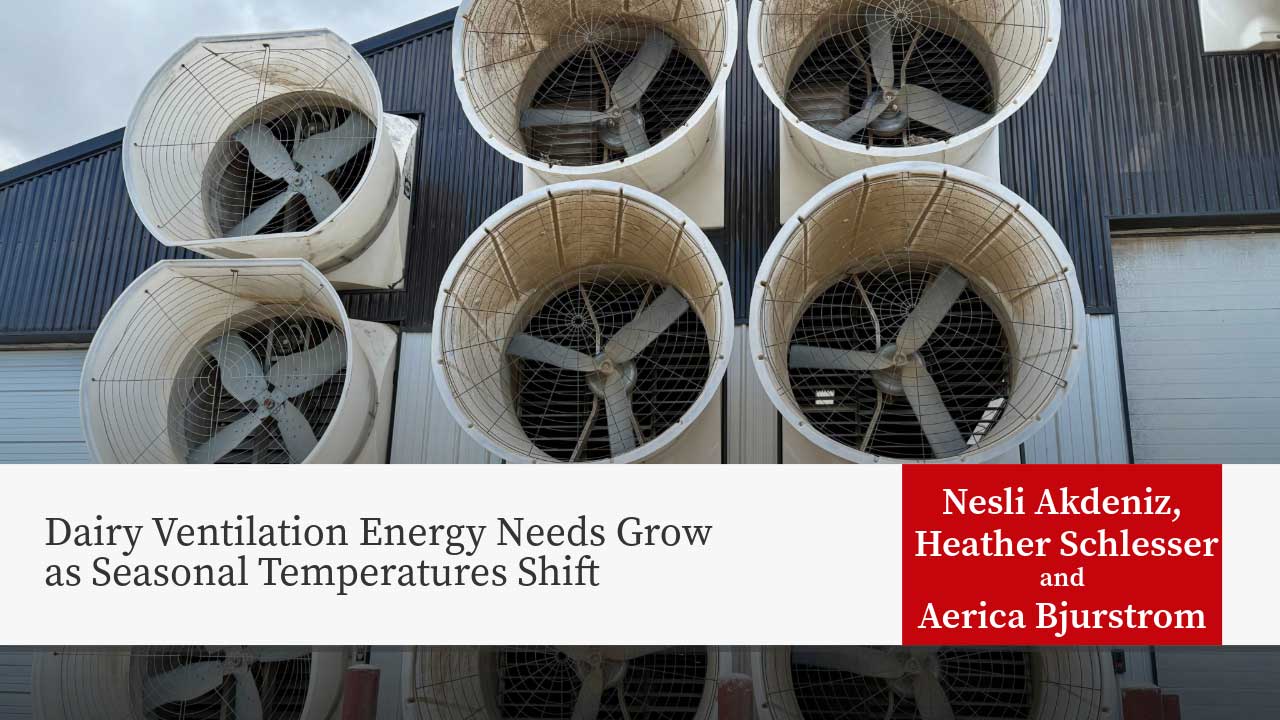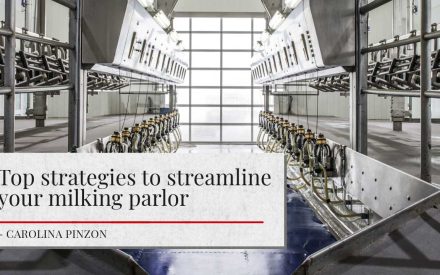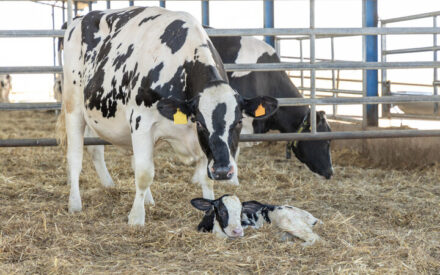
Listen to this article

Aerica Bjurstrom, Nesli Akdeniz and Heather Schlesser.
Seasonal temperature shifts directly affect the energy required to ventilate dairy facilities. In this article, we compared seasonal temperature data from 2020-2024 to those from 2000-2004. To quantify changes in ventilation energy requirements in the last 20 years, we used the following approach:
- We calculated the average number of days when ambient temperatures exceeded 20°C (68°F) and assumed an air exchange rate of 60 air changes per hour (ACH) is needed to keep lactating cows cool on those days.
- We lowered the air exchange rate to 4 ACH when temperatures dropped below 4.4 °C (40 °F).
- During the transition phase, when temperatures ranged between 4.4°C and 20°C (40°F–68°F), we adjusted the ventilation rate in five intermediate steps between 4 and 60 ACH. Although actual ventilation rates on farms are often not managed this precisely, we followed this approach to be able to test the effect of changing seasonal temperatures.
- Calculations were made for two locations in Wisconsin: Wausau (Marathon County), representing the northern/central region, and Madison (Dane County), representing the southern region, where summers tend to be warmer compared to the northern/central region.
- Annual ventilation energy cost per cow was estimated using an average electricity rate of ¢7.24/kWh in 2004 and ¢12.85/kWh in 2024, assuming a fan efficiency of 16 cfm/Watt.
- The Consumer Price Index (CPI) was used to adjust the cost from 2004 to 2024 to make a fair comparison that accounts for inflation.
Table 1 provides a quick summary of the number of summer, transition, and winter days in a year in Madison and Wausau.
| Average number of days per year | |||
|---|---|---|---|
| Winter (T≤4.4°C) |
Transition | Summer (T≥20°C) |
|
| 2020-2024 | |||
| Madison | 131 | 149 | 85 |
| Wausau | 150 | 144 | 71 |
| 2000-2004 | |||
| Madison | 135 | 163 | 67 |
| Wausau | 151 | 157 | 57 |
According to this data, the average number of summer days increased in both cities, rising from 67 to 85 days in Madison and from 57 to 71 days in Wausau. At the same time, the number of transition days (4.4°C < T < 20°C) decreased from 163 to 149 days in Madison and from 157 to 144 days in Wausau, suggesting shorter spring and fall seasons. The number of winter days (T ≤ 4.4°C) remained relatively stable. These changes point to a shift toward longer summers and fewer moderate-temperature days in recent years.
Table 2 summarizes the energy required to operate ventilation fans to meet seasonal air exchange rates in Madison and Wausau. Over the past 20 years, estimated energy consumption increased from 417 to 443 kWh per cow in Madison and from 386 to 404 kWh per cow in Wausau. After adjusting for inflation, this represents a 14% increase in cost in Madison (from $50 to $57) and an 11% increase in Wausau (from $47 to $52). These trends indicate that maintaining adequate ventilation is becoming more expensive for dairy producers due to both changing seasonal temperatures and electricity costs.
| Annual energy consumption and cost | |||
|---|---|---|---|
| 2024 (Electricity rate: ¢12.85/kWh and CPI= 315.6) | |||
| Annual Energy cons. (kWh/head) | Annual cost ($/head) | Value in 2024 ($/head) | |
| Madison | 443 | $57 | $57 (same) |
| Wausau | 404 | $52 | $52 (same) |
| 2004 (Electricity rate: ¢7.24/kWh CPI = 188.9) | |||
| Madison | 417 | $30 | $50 |
| Wausau | 386 | $28 | $47 |
While farmers do not have any control over the seasons, there are still steps they can take to keep ventilation costs low. This includes choosing the right fan, keeping fans well-maintained, making sure the air inlets are correctly sized, and placing the milking robots or other equipment parallel to the airflow. Farmers can also use the Cool Cows Calculator, available at go.wisc.edu/coolcows ↗️ and go.wisc.edu/coolcows2 ↗️, to evaluate how efficiently their ventilation systems are operating.
Conclusion
In conclusion, as seasonal temperatures shift, effectively managing ventilation becomes increasingly important for maintaining cow comfort and controlling energy costs. This study focused on the impact of seasonal temperature changes on ventilation fan requirements, but future research could explore additional factors such as genetic improvements, higher milk yields, and the role of circulation fans, which can double ventilation costs in some facilities.
Authors

Neslihan Akdeniz
Livestock Controlled Environments Extension Specialist, Assistant Professor– Mainly focusing on controlled environments for livestock production, also interested in nutrient management and indoor plant-growing facilities.

Heather Schlesser
County Dairy Educator – Heather Schlesser is an Agriculture Educator in Marathon County. Heather’s research and outreach have included the use of current technology to enhance farm profitability and sustainability. Her current projects include the Animal Wellbeing Conference, the Midwest Manure Summit, Beef Quality Assurance, financial programming, and teaching farmers throughout the Midwest how to breed their own cattle.

Aerica Bjurstrom
Regional Dairy Educator – Aerica’s work focuses on herd health and animal welfare. She also has a strong background in meat quality and has done programming in market cow carcass quality.
References
- Consumer Price Index, U.S. Bureau of Labor Statistics: https://www.bls.gov/cpi/ (8-2-2025).
- CoolCows Calculator, UW-Madison Extension, https://go.wisc.edu/coolcows (8-2-2025).
- Electric Sales, Revenue, and Average Price (Table 5b): https://www.eia.gov/electricity/sales_revenue_price/ (8-2-2025).
- Mondaca, M.R., Cook, N.B. 2019. Modeled construction and operating costs of different ventilation systems for lactating dairy cows. Journal of Dairy Science, 102: 896-908. https://doi.org/10.3168/jds.2018-14697
Download Article


 Case Study of a Mastitis Investigation in an Automatic Milking System (AMS)
Case Study of a Mastitis Investigation in an Automatic Milking System (AMS) Top strategies to streamline your milking parlor
Top strategies to streamline your milking parlor Activity Monitoring Technology for Reproductive Management of Dairy Cows
Activity Monitoring Technology for Reproductive Management of Dairy Cows ▶️ Watch: New Technologies in Dairy Farming
▶️ Watch: New Technologies in Dairy Farming


